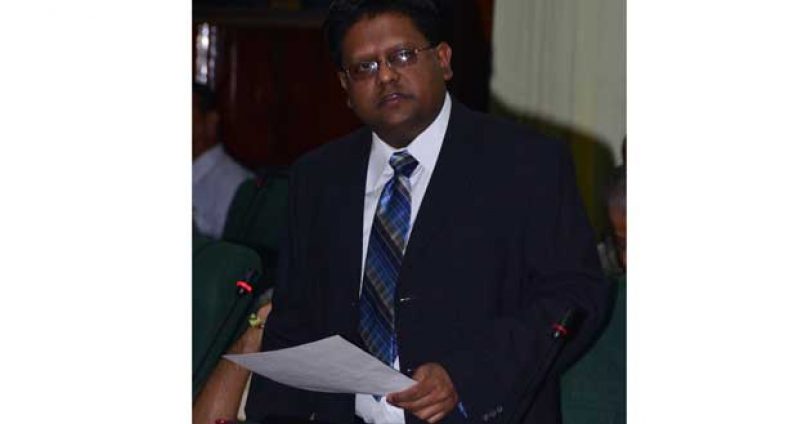FINANCE MINISTER, Dr. Ashni Singh, has said that the Bureau of Statistics is the sole custodian of the database generated from the 2012 Census, as obtained with previous such processes.
And data from the census is disseminated only in summarized and aggregated formats, as is required by law. As such, no officer from the Ministry of Finance has access to any data of the 2012 census.His comments followed questions from the Alliance For Change (AFC) Member of Parliament (MP) Cathy Hughes, who was enquiring whether the Finance Ministry or any of its officers had been given access to any of the data from the 2012 National Census; and when the results of the 2012 Census would be released.
PRELIMINARY REPORT
Minister Singh added that the Bureau’s preliminary report on the 2012 census is expected to be released by June.
He explained that the report will include the preliminary population count; the country’s gender distribution; the population distribution by coastland and hinterland distribution; the regional population density; the number of households, and average household size by region; the number of business places by region; and the regional population growth rates, among other details.
“The more detailed analyses on such parameters as the age distribution of the population, ethnicity, educational levels, economic activities and labour force will follow in a larger and final report, which is expected to be completed in December 2015,” he said.
In a prior comment on the matter, the Finance Minister had made it clear that the extraction of data from the “comprehensive” questionnaires is currently being done, in addition to tabulation and analysis.
The national census has been hailed as not only of importance to the country itself, but to the Caribbean Region as well. Member countries of the Caribbean Community (CARICOM) are participating in the World Population and Housing Census programme, and data from it is one of the wide ranges of statistics from the National Bureau of Statistics and other agencies in member states that the CARICOM Secretariat collects.
These statistics are compiled in regional databases and then disseminated to users regionally and internationally, and the Secretariat would partner with international agencies such as the European Union (EU) and the Inter-American Development Bank, among others, to seek to build capacity in member countries to produce statistics required for policy formulation and the strengthening of the CARICOM Single Market and Economy (CSME).
MASSIVE EXERCISE
Because of the massive, demanding and costly nature of the Census exercise, this activity is held just once every 10 years in most countries. Guyana has traditionally organised its censuses with the rest of the other CARICOM countries under the coordination of the Statistics Division of the CARICOM Secretariat. Additionally, Guyana’s Census is part of the Global Round of Population and Housing Censuses for the current 2010 Round, whereby almost all countries which are Members of the United Nations have conducted and completed their national censuses during the period, which commenced in 2005 and concludes in 2014, the demarcated period for the 2010 Round of Censuses.
The Census is the only national exercise in which every building is counted; and every household within every building, or any economic activity within each building is enumerated and/or recorded at the same period in time. The Census is, and has always been, much more than a headcount; it is a check and evaluation of the following: changing size, composition, quality of life, economic activities, maternal health, fertility rates, housing stock, qualification and education levels, foreign-born population, and access to basic social services, just to name a few.
The plethora of information that would be collected is also expected to assist policy makers to determine whether Guyana is on track to achieve several of the Millennium Development Goals (MDGs).
In his 2012 budget speech, the Finance Minister had said, “This Government has long recognised the critical importance of every country executing a census of its population and housing facilities every ten years, as is the global standard; and in keeping with this cycle, censuses were conducted in 2002 and previously in 1991. Another decade has now passed, and the 2010 Round of Global Censuses, which runs until 2014, is now in its final stages. Guyana continues to be a part of the regional approach to census-taking coordinated by the CARICOM Secretariat.
“The size, composition and dispersion of our population are also matters of national security, and it is for these reasons and more that all countries — and Guyana is no exception – recognise the critical importance of the census exercise to human and economic development, evidence-based policy making, and ensuring the security of their citizenry. Government now intends for the next national census to be executed in the second half of 2012…”
On signing the Census Order and Regulations, Dr. Singh had said, “Census 2012 represents our latest efforts to update the vast array of data we compile on national life to inform policy-making by Government and decision-making by other stakeholders such as the business community. I have no doubt that the 2012 census will prove equally valuable in this regard, and I wish the Bureau of Statistics every success in executing this important national activity.”
In Census 2002, the last census in Guyana, the nation’s resident population was 751,000; and in April, some $327M were allocated in the 2014 Budget to the Statistical Bureau and approved by the National Assembly, an increase over the $246M in 2013.
(By Vanessa Narine)



.jpg)








